
* The Hind was exported to many foreign states and fought in many conflicts. Many Hinds remain in service with both foreign states and the various Soviet successor states, and a number of firms are providing upgrades to keep the machines effective. In the last days of the Soviet Union, the Mil organization tried to develop a new attack helicopter, the Mi-28 Havoc, that incorporated the lessons learned from the Hind. This chapter provides an outline of the Hind's use in foreign service and Soviet successor states, and also gives a description of the Mi-28.
* The Hind-series gunships were widely exported in specific export variants, with slightly downgraded avionics. The "Mi-25" was an export version of the Hind-D, while the "Mi-35" was similarly an export version of the Hind-E, and the "Mi-35P" was an export version of the Hind-F.
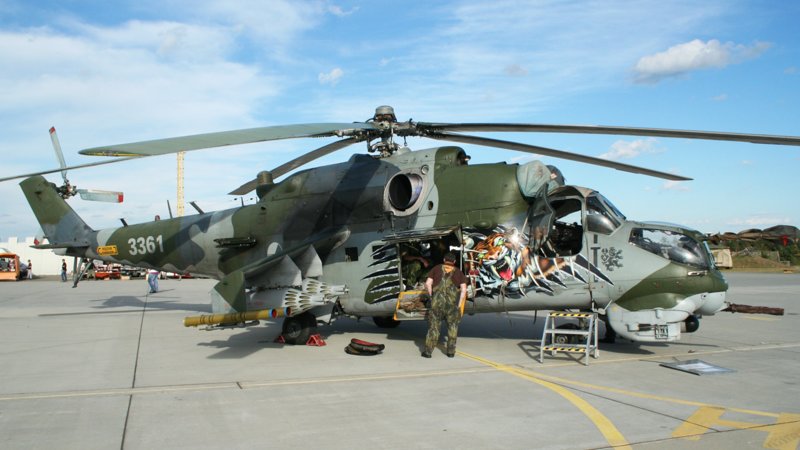
The Iraqis were early foreign operators of the Hind, obtaining them beginning in the late 1970s. It is unclear how many Hinds were purchased by Iraq, but the number was apparently about 60. Iraqi Hinds saw particularly heavy action during the Iran-Iraq War of 1980:1988. The gunships were used extensively for ground attack on Iranian troops, inflicting great slaughter and acquiring a fearsome reputation. They were also the first helicopters to engage in serious air-to-air combat with other helicopters, in the form of Iranian AH-1J SeaCobra gunships.
The Hind had been more or less inspired by the American Bell Cobra, and Hind crews regarded the Cobra as their natural enemy. Although the Hind was faster and tougher, the Cobra was more agile. Soviet evaluations had demonstrated that in a contest between two helicopters, the one that could turn more tightly was likely to win.
According to a story, the Cobra's advantage in maneuverability over the Hind had been demonstrated in the early 1980s. A Soviet Hind based in East Germany was flying along the border with West Germany, playing "cat" to a US Army Cobra flying on the other side of the border in the role of "mouse". The Cobra pilot was a "real pro", and the Hind pilot lost control trying to follow his maneuvers. The Soviet gunship went into the ground, killing its crew. This "kill" could be chalked up more to the Soviet pilot's fatal lack of judgement than to the American pilot's skill, and in fact the Iraqis demonstrated that the contest between Hind and Cobra was far from one-sided.
It might not have seemed so at first. In November 1980, not long after the beginning of the war with Iraq's invasion of Iran on 22 September 1980, two Iranian SeaCobras crept up on two Hinds and hit them with TOW wire-guided antitank missiles. One Hind went down immediately, the other was badly damaged and crashed before reaching base. The Iranians pulled off a repeat performance on 24 April 1981, destroying two Hinds without loss to themselves.
Then the Iraqis hit back, claiming the destruction of a SeaCobra on 14 September 1983; three SeaCobras on 5 February 1984; and three more on 25 February 1984. Things went quiet for a time, and then on 13 February 1986 each side lost a gunship. A few days later, on 16 February, a Hind shot down a SeaCobra, with a SeaCobra claiming a Hind in return on 18 February. The last engagement between the two types was on 22 May 1986, when the Hinds shot down a SeaCobra.
The score in the end was 10 kills on SeaCobras and 6 kills on Hinds. The relatively small numbers and the inevitable disputes over actual kill numbers makes it unclear if one gunship had a real technical superiority over the other. It appears that the outcome of the fights was dependent more on the tactical situation and pilot skill than the inherent merits of each machine. Iraqi Hinds also claimed a total of 43 kills against other Iranian helicopters, such as Agusta-Bell Hueys. One Hind even shot down an Iranian McDonnell F-4D Phantom jet fighter on 26 October 1982, though different sources give conflicting details of the incident.
After the Iran-Iraq War, Iraqi Hinds were also used in punitive operations against rebellious Kurdish villages in northern Iraq. These attacks involved use of chemical agents against civilians, though it appears that the chemical agents were delivered by fixed-wing aircraft. Hinds also helped lead the way in the invasion of Kuwait in August 1990, with a few of the gunships lost to ground fire.
When US-led Coalition forces took Kuwait back in early 1991, the Hinds kept a low profile. Saddam Hussein, expecting defeat, kept them in reserve to help maintain power after the conflict. One was captured and three destroyed by Coalition ground forces during the war.
* Hinds were obtained by India in numbers, with Indian machines seeing combat during the intervention in Sri Lanka in 1987:1989. They remain in service in India. Syria was another big user, having used them with success against Israeli armor during the fighting in south Lebanon in 1982, and still flying them during the uprising in Syria in the next century.
Warsaw Pact nations of course acquired them as well, users including Bulgaria, Czechoslovakia, East Germany, Hungary, and Poland. They have since generally been retired. Numbers of Hinds were also obtained by the Yugoslav successor states, while they are still flying with the Soviet successor states.
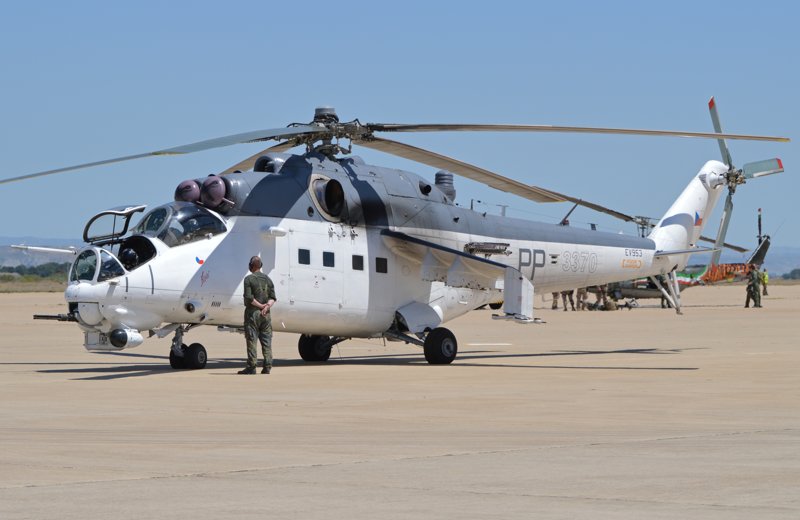
The Hind figured prominently in the various "Wars of the Soviet Succession" that followed the collapse of the USSR, most prominently the Russian campaigns in Chechnya. The Chechnya fighting did much to illustrate the deterioration of the Russian Army and Hind operations were no exception, with gunships operating with feeble munitions loads due to limited stockpiles, suffering from running maintenance difficulties, and reports of Hinds causing "friendly fire" casualties due to poor aircrew training. A number of Russian Hinds were also lost in action.
Ukrainian Hinds and other helicopters served in less violent roles in support of United Nations peacekeeping forces in the former Yugoslavia, with their machines neatly painted in UN white. UN commanders found the Ukrainian forces and their weapons a real asset to the mission.

Hind users in Africa have included Algeria, Angola, Ethiopia, Libya, Mali, Mozambique, Nigeria, Senegal, Sierra Leone, Sudan, and Zimbabwe. They saw plenty of action in the brushfire conflicts that have afflicted the continent. The only other Middle Eastern users besides Iraq and Syria were Cyprus and Yemen.
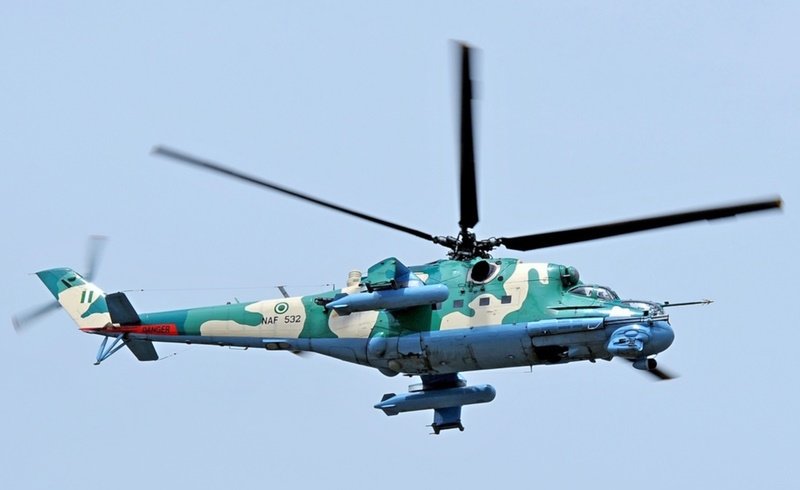
* The US Army managed to obtain a few Hinds during the 1980s for evaluation and training, but in the main during that decade the US had to make do with Bell UH-1H Hueys dressed up, not at all convincingly, as Hind surrogates for training. These training Hueys were redesignated "JUH-1H".
The Army then signed a contract with Orlando Helicopter Airways (OHA) in Florida to build more convincing fake Hinds, apparently partly as targets. OHA took 15 old Sikorsky S-55 / H-19 piston-powered helicopters and did a surprisingly good job of converting them into something that looked like a Hind, even fitting them with five-blade rotors in place of their original three-blade rotors. They weren't perfect facsimiles by any means, but they resembled the real Hind well enough to be adequate for training purposes. The Army also found them highly reliable, a testimony to Sikorsky's tradition of sound engineering.
In the 1990s, the collapse of the Warsaw Pact has eliminated almost all barriers to purchase of Hinds except for coming up with the money, and the US Army has been able to train with real Hinds instead of surrogates -- more on that later.
The Hind saw further action in Russian military operations in the 21st century. Hinds were in combat on both sides following the Russian invasion of Ukraine in 2022; not much is known about their service there, but it is clear they suffered. There were just too many battlefield surface-to-air missile systems, which rendered front-line air combat operations very risky, many machines being shot down. The Ukrainians tended to use their Hinds as flying barrage rocket launchers, coming at low altitude, climbing and firing their rockets, then turning around to go back home low, dumping flares to cover their tracks. The war strongly hinted that the days of piloted helicopter gunships may be numbered, or at least the concept had to be rethought.
BACK_TO_TOP* The Hind gunship has continued to evolve in the 21st century. The Mil design organization and its corresponding manufacturing organization -- now a commercial firm named "Rostvertol" -- developed the modernized "Mi-35M", with the first of three prototypes initially flown in 1999, and the two others in 2001. The Mi-35M featured:
Possible antitank stores included the old AT-6 Spiral, the laser-guided Ataka (AT-12) antitank missile, and the newer laser-guided Vikhr (AT-16) antitank missile. The Igla V AAM, the Russian answer to the American Stinger, could also be carried.
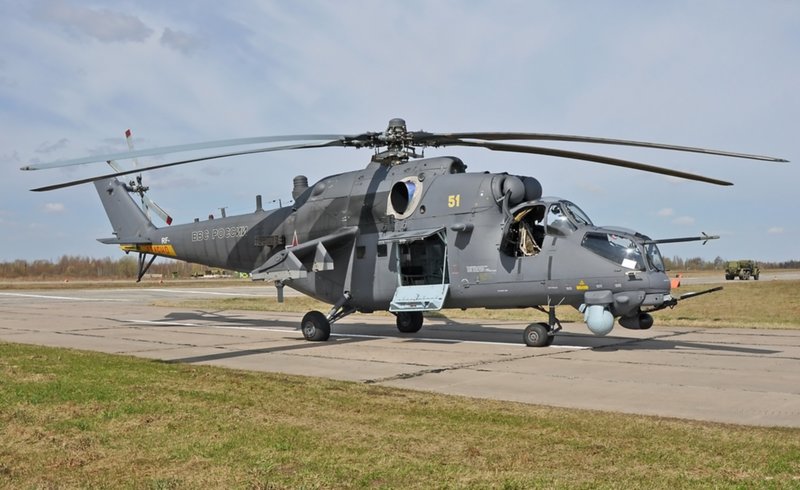
The first two prototypes were fitted with standard Isotov TV3-117 turboshafts. The third was fitted with production-standard Klimov VK-2500-02 turboshafts with 1,640 kW (2,200 SHP) each, featuring a 20% power boost for emergency single-engine operation. The new engines featured a surge protection system to cope with gun gas ingestion.
The Mi-35M was offered both as new-build machines and upgrades. Over 180 35Ms were delivered to eleven different export operators between 2005 and 2023, including Azerbaijan, Belarus, Brazil, Iraq, Kazakhstan, Mali Nigeria Pakistan Serbia Uzbekistan and Venezuela. Iraq was the biggest user, obtaining 28, with deliveries from 2013. Belarus has also obtained the type, and least 55 were obtained by the Russian Aerospace Forces (RuASF), while five were obtained for the air arm of Russia's Federal Security Service (FSB).
* Work on the Mi-35M was leveraged into upgrades for older Hinds. The Russian Army obtained an upgrade of the Mi-24P Hind-F, the "Mi-24PN", where the "N" stood for "night capability". It featured fixed landing gear, a new day-night targeting system, an NVG-compatible partial glass cockpit, a countermeasures suite, and support for advanced missiles such as listed above. The Russian military acquired Mi-24PNs as funds become available, accepting their first five upgrades in early 2004. Rostvertol has continued to offer refined upgrade packages -- though international sanctions implemented following the invasion of Ukraine disastrously affected all Russian industry, with the war also destabilizing Russia.
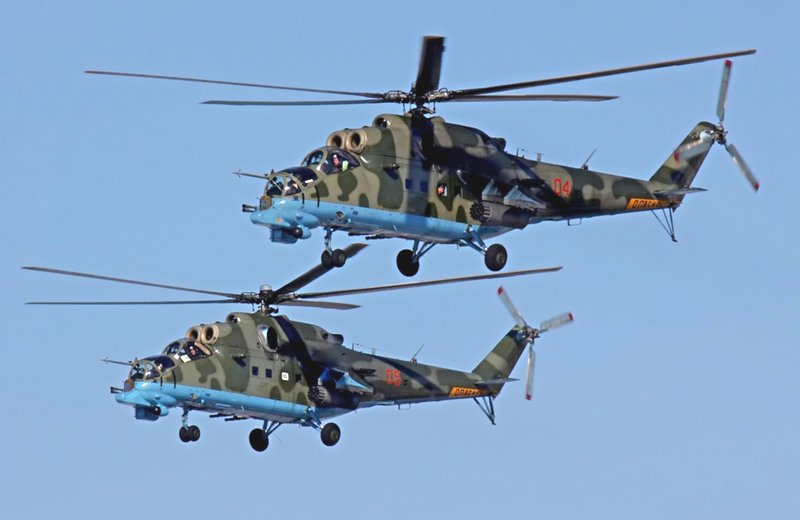
Ukraine's AVIAKON organization, which was established in Soviet days to provide maintenance support for Soviet-built helicopters, has performed upgrades on Ukrainian Hinds as well, improvements including engine upgrades, improved avionics, a countermeasures suite, helmet-mounted sights, night vision goggle-compatible cockpits, and so on, with avionics supplied by SAGEM of France.
India conducted an upgrade program from 1998 for at least 24 of their Hinds, with the work being performed by the Tamam division of Israeli Aircraft Industries (IAI). Tamam labeled the upgrade package "Mission 24", apparently to emphasize night operation, and the package included:
Of course, Tamam has also offered similar upgrades for other Hind users. Elbit of Israel has promoted Hind upgrades, and apparently has had some takers.
However, trying to sort out Hind upgrade programs is troublesome. Upgrade programs are announced, only to stall and then fade out, having foundered on lack of money, or on resistance from the Russians -- who have, of course, been very touchy about "unauthorized" upgrade work on Hinds, citing their intellectual property rights. A South African company named Advanced Technologies & Engineering (ATE) came up with a comprehensive "Super Hind" upgrade, with Westernized avionics and weapons carriage. Algeria had 34 Mi-24s upgraded to the Super Hind standard.
ATE then attempted to promote the Super Hind upgrade to other Mi-24 users. The Russians moved against ATE, spreading "FUD (Fear Uncertainty Doubt)" about the company. ATE did upgrade ten Azerbaijani Mi-24s to a limited Super Hind standard, retaining carriage of Russian-style weapons. ATE ended up being bought up by the South African Paramount group -- which established a partnership with the Russian Yakovlev organization. That was the end of the Super Hind.
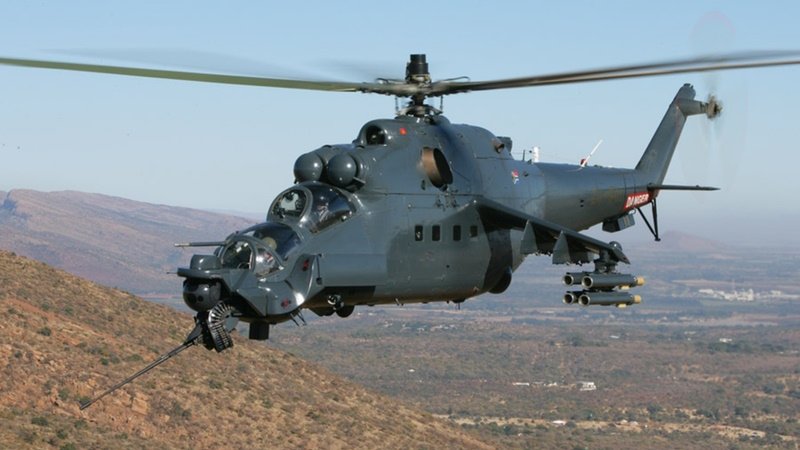
The Polish WZL-1 organization did turn out a few modest upgrades of Polish Hinds for the combat search and rescue role, with these machines receiving the appropriate designation of "Mi-24CSAR".
BACK_TO_TOP* The mixed transport-gunship configuration of the Hind-series helicopters having proven no great benefit, the Mil bureau decided to follow up with an improved machine much more along the lines of Western helicopter gunships -- this design emerging the Mil "Mi-28". Development began in 1980, with the first of four prototypes performing its initial flight on 10 November 1982. It was given the relatively flattering NATO reporting name of "Havoc" -- which, coincidentally, reflected on the US Douglas A-20 Boston / Havoc bomber of World War II, which the Soviets flew in large numbers. The second two prototypes had uprated engines and some other tweaks, and were designated "Mi-28A".
Due to the collapse of the Soviet Union, the Mi-28 remained in the wings for well over a decade. The post-Soviet Russian Army did have a requirement for a new gunship helicopter, but the Havoc lost that competition in 1994 to the Kamov Ka-50 "Hokum". Mil didn't give up on the Mi-28, however. Even though the Hokum had "won" the competition, the Russian Army didn't have the funding to commit to production, making the win meaningless.
In any case, in 1994, the Russian Army announced that they had funded development of a night / all-weather attack version of the Havoc. In the spring of 1997, the Mil bureau publicly unveiled the prototype of the improved "Mi-28N Havoc-B", where "N" stood for "Nochnoy (Night)". First flight of the Mi-28N prototype was on 14 November 1996. The Havoc-B prototype was a rebuild of the original Havoc prototype. The program moved slowly -- a second prototype didn't fly until 2004 -- but the first production machines finally flew in 2005, with initial service deliveries in 2008, and introduction to service in 2010.
* The Mi-28N, as it emerged, had a general configuration similar to that of the US AH-64 Apache, but calling it an "Apachski" would be unfair, since it clearly differed in detail. It had a conventional main-tail rotor configuration; was powered by twin TV3-117KM turboshafts with 1,640 kW (2,200 SHP) each, and with intake filters; and had fixed landing gear. The main rotor had five blades. While the first two prototypes were fitted with a three-blade tail rotor, the third had twin "scissors"-type two-bladed rotors.
The gunner and pilot had their own cockpits, with the pilot in the raised back cockpit. The crew sat in shock-absorbing seats that could handle crash landings at up to 12 meters (40 feet) per second. The cockpit windows were plated with flat no-glint armor glass, while titanium and ceramic armor was used to protect the aircrew and vital rotorcraft systems. Systems were arranged so that the most critical were the least exposed, and redundancy is used to help ensure survivability. The machine had an escape system that blew off the rotors and inflated air bladders to protect the crew while they were bailing out.
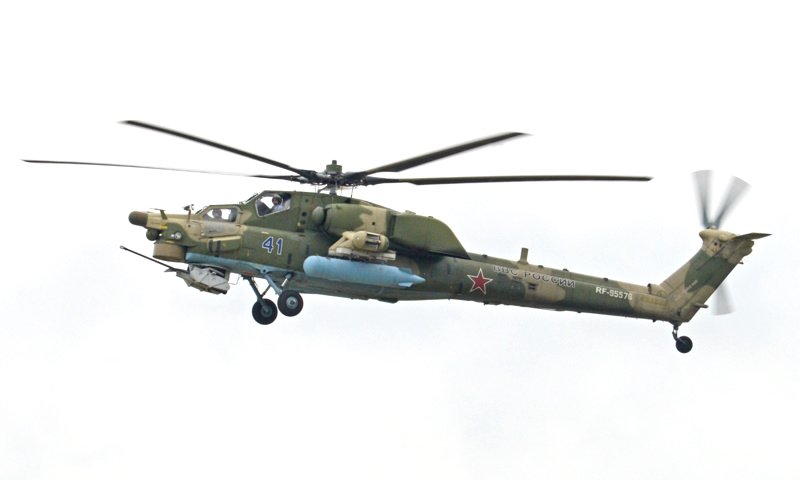
Built-in armament consisted of a turret with a single-barreled "2A42" 30-millimeter cannon. The turret could elevate 13 degrees, depress 40 degrees, and traverse 110 degrees from each side of the centerline. Twin 150-round ammunition boxes were mounted on the turret itself, to reduce the probability of ammo feed jams. The gun could be selected for a 300 round per minute rate of fire for surface targets, or a 900 round per minute rate of fire for air combat.
Each stub wing had two pylons, for a total of four. Each pylon had a carriage capability of 480 kilograms (1,058 pounds) and could carry a four-round launcher for AT-6 Spiral antitank missiles, an unguided rocket pod, or other stores. Sensor and targeting systems were fitted. Each wingtip had a chaff-flare dispenser, and engine exhaust infrared suppressors were fitted.
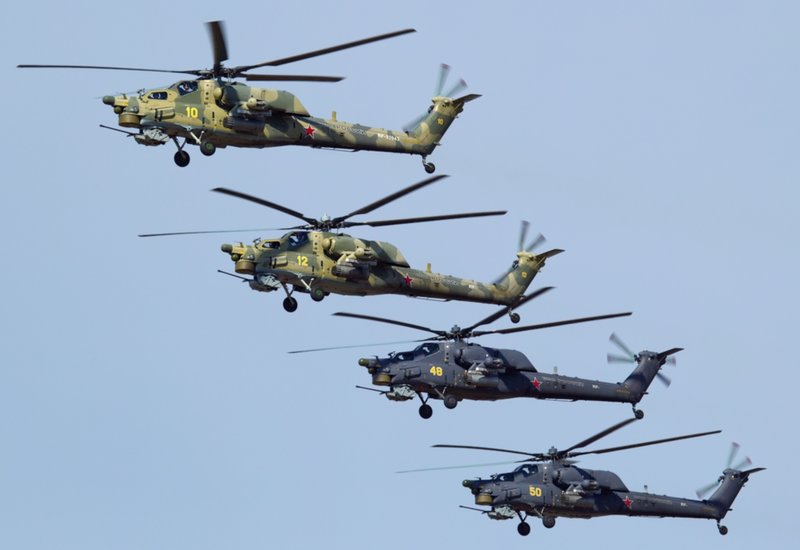
The Havoc had a small cargo compartment of sorts, its main rationale being to allow one helicopter to rescue the crew of another. The compartment could be used to carry ammunition reloads as well.
___________________________________________________________________
MIL MI-28A HAVOC:
___________________________________________________________________
main rotor diameter:
17.2 meters (56 feet 5 inches)
tail rotor diameter:
3.84 meters (12 feet 7 inches)
fuselage length:
17.01 meters (55 feet 10 inches)
footprint length:
21.13 meters (69 feet 4 inches)
height (tail rotor):
3.82 meters (12 feet 6 inches)
height (rotor head):
4.7 meters (15 feet 5 inches)
empty weight:
8,095 kilograms (17,845 pounds)
max loaded weight:
11,500 kilograms (23,355 pounds)
maximum speed:
300 KPH (186 MPH / 162 KT)
service ceiling:
5,800 meters (19,000 feet)
range:
470 kilometers (292 MI / 254 NMI)
___________________________________________________________________
The Mi-28N featured a daylight TV / FLIR turret embedded in the nose and a mast-mounted millimeter-wave Kinzal-V or Arbalet targeting radar. Other improvements include an enhanced cockpit layout; slightly improved 30-millimeter cannon; modified rotor blades with swept tips; and uprated engines with 1,640 kW (2,200 SHP) take-off power each. Kenya has obtained 16 "Mi-28NE" export machines, while Iraq has obtained a total of 42 Mi-28NE machines -- the order also including 24 modernized Mi-35M Hind machines; Algeria and Venezuela have also acquired the Mi-28NE.
In 2013, Rostvertol introduced a dual-control trainer, the "Mi-28UB", with features such as full dual controls, larger instructor's cockpit and canopy, plus new crashworthy seats. It was fully combat-capable, being intended to support conversion and operational training. Algeria obtained the dual-control variant, and the Russian Air Force ordered 24 of them, with initial deliveries in late 2017.
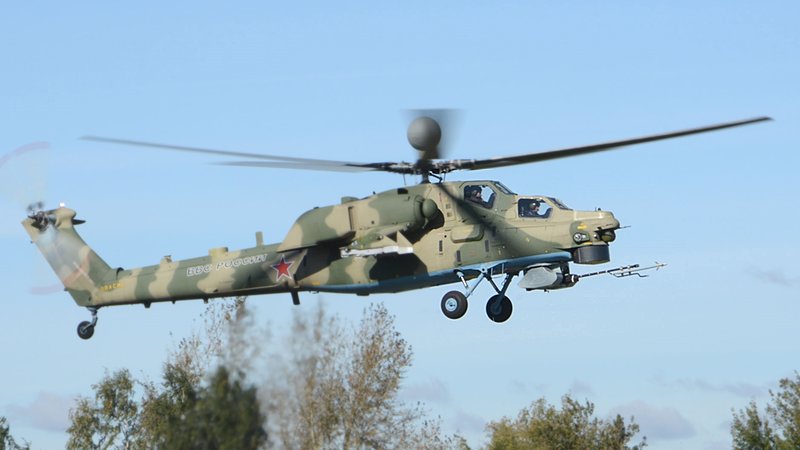
Images of a prototype of the modernized "Mi-28NM" were released in 2016, the new variant including:
The Mi-28NM replaced the prominent nose radome of the Mi-28N with a smooth nose housing a missile guidance unit. Initial flight of the Mi-28NM was on 12 October 2016. Initial deliveries were in 2020 or 2021. By the start of 2023, following the four prototypes, it appears that about 110 Mi-28Ns were built, plus the 24 Mi-28UBs, and a handful of Mi-28NMs.
The Havoc fought in the Ukraine War -- like the Hind, suffering from ferocious Ukrainian air defenses, again suggesting that the helicopter gunship concept had to be rethought. The conflict was also economically and socially calamitous to Russia, and it is not clear now that Russia will have the capability to produce the Mi-28 in the aftermath.
BACK_TO_TOP* The US Army first got their hands on a Hind-D gunship in the mid-1980s, before the fall of the USSR. An Army helicopter pilot, Chief Warrant Officer Jeff Stayton, was assigned to figure out how to fly the thing, assisted only by a translation of the instruction manual. Stayton was impressed by the size of the beast -- it was three times heavier than a Cobra -- and also by its solid cockpit armor. The armor glass was so thick that it was almost as tough as armor plate, and the cockpit view was excellent. Experience with the machine showed that it was a very good example of Soviet design philosophy, being "tractor tough", much more reliable and easy to maintain under field conditions than any American helicopter.
Stayton was also impressed by the machine's idiosyncrasies. One was that the helicopter's APU had a tendency to blast out a gush of flame when it was fired up, which was startling but harmless. Another eccentricity was that the big wings on the Hind prevented it from hovering, at least for any length of time, because they blocked the rotor downdraft. Apparently the cut-down wings on the Mi-35M were introduced to permit a hover capability.
Stayton quickly learned to regard the Hind as a hybrid of a helicopter and a fixed-wing aircraft. It was very fast but not maneuverable, and in fact in a banking turn the dropped wing lost lift, which tended to flip the helicopter over onto its back. Stayton had fixed-wing flight experience and was able to compensate the first time he ran into this difficulty by putting the nose down to build up speed, but this maneuver would not be possible in low-level "nap of earth" operations. Stayton judged the Hind's unusual flying characteristics as design trade-offs, not design flaws. More Hinds were obtained for US Army service, operating as aggressor training machines, and Army pilots have praised it -- saying it is quiet, gives a very smooth ride, "like an old '62 Cadillac." Stayton felt it was more fun to fly than any other helicopter he ever got his hands on.
* Describing Soviet weapons is always tricky. The Soviets were big on secrecy and misinformation, sometimes to the point of lunacy, making for a trail both faint and muddy. The result was that building this document involved multiple rewrites of designations as I went from source to source. In addition, I leaned toward use of the Western "Hind" designations wherever possible, simply because they were a bit easier to keep straight than the Soviet / Russian designations. I ask forgiveness if this seems a bit disrespectful. Certainly the Russian name "Crocodile" seems far more fitting.
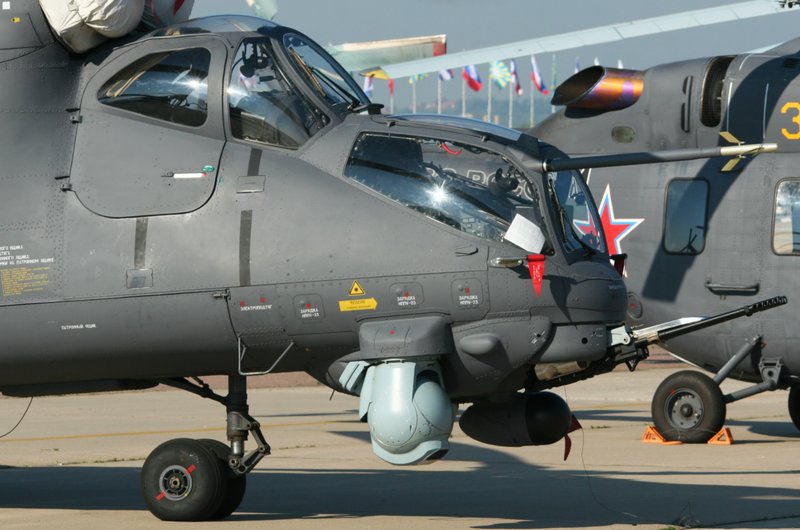
* Sources include:
* Illustrations credits:
* Revision history:
v1.0.0 / 01 oct 02 v1.1.0 / 01 apr 03 / Comments on upgrades, split into chapters. v1.1.1 / 01 apr 05 / General cleanup and update. v1.1.2 / 01 apr 07 / Review & polish. v1.1.3 / 01 apr 09 / Review & polish. v1.1.4 / 01 may 10 / Review & polish. v1.1.5 / 01 apr 12 / Review & polish. v1.1.6 / 01 mar 14 / Mi-28UB trainer. v1.2.0 / 01 feb 16 / Various updates. v1.3.0 / 01 jan 18 / Quick cleanup. v1.4.0 / 01 dec 19 / General rewrite. v1.5.0 / 01 mar 23 / Review & polish. v1.5.1 / 01 apr 25 / Review & polish. (+)BACK_TO_TOP
